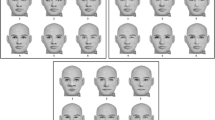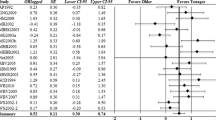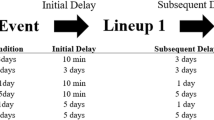Abstract
Study 1 (N=205) reveals that witnesses often provide vague descriptions. Witnesses leave out information such as sex and race that they certainly noticed (default values). Study 2 (N=89) weakly supports the claim (Luus & Wells, 1991) that correct identification rates from lineups are enhanced by selecting foils who fit the description of the criminal rather than foils who are highly similar to the suspect. Study 3 (N=210) indicates that false identification rates can be inflated by selecting lineup foils who fit vague descriptions of the criminal but otherwise differ from the suspect on default values.
Similar content being viewed by others
References
Cutler, B., & Penrod, S. (1988). Improving the reliability of eyewitness identification: Lineup construction and presentation.Journal of Applied Psychology, 73, 281–290.
Lindsay, R. C. L. (1986). Confidence and accuracy of eyewitness identification from lineups.Law and Human Behavior, 10, 229–239.
Lindsay, R. C. L. (1993). Biased lineups: Where do they come from? In D. Ross, D. Read, & M. Toglia (Eds),Adult eyewitness memory: Current trends and developments. Cambridge: Cambridge University Press.
Lindsay, R. C. L., Lea, J. A., Nosworthy, G. J., Fulford, J. A., Hector, J., Levan, V., & Seabrook, C. (1991). Biased lineups: Sequential presentation reduces the problem.Journal of Applied Psychology, 76, 796–802.
Lindsay, R. C. L., Nosworthy, G. J., Martin, R. R., & Martynuck, C. (1994). Finding suspects in mugshots.Journal of Applied Psychology, 79, 121–130.
Lindsay, R. C. L., Wallbridge, H., & Drennan, D. (1987). Do the clothes make the man? An exploration of the effect of lineup attire on eyewitness identification accuracy.Canadian Journal of Behavioural Science, 19, 463–478.
Lindsay, R. C. L., & Wells, G. L. (1980). What price justice? Exploring the relationship of lineup fairness to identification accuracy.Law and Human Behavior, 4, 303–313.
Lindsay, R. C. L., & Wells, G. L. (1985). Improving eyewitness identification from lineups: Simultaneous versus sequential lineup presentation.Journal of Applied Psychology, 70, 556–564.
Luus, C. A. E., & Wells, G. L. (1991) Eyewitness identification and the selection of distracters for lineups.Law and Human Behavior, 15, 43–57.
Malpass, R. S. (1981). Effective size and defendant bias in eyewitness identification lineups.Law and Human Behavior, 5, 299–309.
Navon, D. (1992). Selection of lineup foils by similarity to suspect is likely to misfire.Law and Human Behavior, 16, 575–593.
Wells, G. L. (1993). What do we know about eyewitness identification?American Psychologist, 48, 553–571.
Wells, G. L., Leippe, M. R., & Ostrom, T. M. (1979). Guidelines for empirically assessing the fairness of a lineup.Law and Human Behavior 3, 285–293.
Wells, G. L., & Lindsay, R. C. L. (1985). Methodological notes on the accuracy-confidence relation in eyewitness identifications.Journal of Applied Psychology, 70, 413–419.
Wells, G. L., Rydell, S. M., & Seelau, E. P. (1993). The selection of distractors for eyewitness lineups.Journal of Applied Psychology, 78, 835–844.
Author information
Authors and Affiliations
Additional information
This research was supported by grants to the first author from the Social Sciences and Humanities Research Council of Canada.
About this article
Cite this article
Lindsay, R.C.L., Martin, R. & Webber, L. Default values in eyewitness descriptions. Law Hum Behav 18, 527–541 (1994). https://doi.org/10.1007/BF01499172
Issue Date:
DOI: https://doi.org/10.1007/BF01499172




